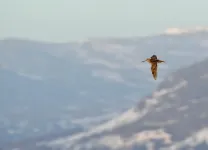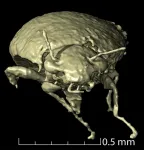(Press-News.org) Fossilized feces are common finds at paleontological dig sites and might actually contain hidden treasures. By scanning fossilized dung assigned to a close dinosaur relative from the Triassic period, scientists discovered a 230-million-year-old beetle species, representing a new family of beetles, previously unknown to science. The beetles were preserved in a 3D state with their legs and antennae fully intact. The finding appears June 30 in the journal Current Biology.
The discovery that fossilized droppings, also known as coprolites, can preserve ancient insect species offers a new alternative to amber fossils--fossilized tree resin, which normally yield the best-preserved insect fossils. The oldest insect fossils from amber, however, are approximately 140-million-years old, and thus from relatively recent geological times. With coprolites, researchers can now look even further into the past, allowing them to learn more about insect evolution and food webs of yet unexplored time intervals.
"We didn't know how insects looked in the Triassic period and now we have the chance," says Martin Fikáček (@fikacek_martin), an entomologist at National Sun Yat-sen University, Taiwan and a co-author on the paper. "Maybe, when many more coprolites are analyzed, we will find that some groups of reptiles produced coprolites that are not really useful, while others have coprolites full of nicely preserved insects that we can study. We simply need to start looking inside coprolites to get at least some idea."
"I was really amazed to see how well preserved the beetles were, when you modeled them up on the screen, it was like they were looking right at you," says first author Martin Qvarnström (@M_Qvarnstroem), a paleontologist at Uppsala University, Sweden and a postdoctoral fellow in the lab of Per Ahlberg. "This is facilitated by coprolites' calcium phosphatic composition. This together with early mineralization by bacteria likely helped to preserve these delicate fossils."
The research team named the new beetle species Triamyxa coprolithica, which refers to its Triassic age and indicating that it belongs to the suborder Myxophaga--whose modern rep-resentatives are small and live on algae in wet environments--and that it was found in a cop-rolite. Triamyxa likely lived in semiaquatic or humid environments and were likely consumed by Silesaurus opolensis--the probable producer of the coprolite--a beaked dinosaur ancestor about 2 meters long and 15 kilograms that lived in what is now Poland at the same time.
"Although Silesaurus appears to have ingested numerous individuals of Triamyxa coprolithi-ca, the beetle was likely too small to have been the only targeted prey," says Qvarnström. "Instead, Triamyxa likely shared its habitat with larger beetles, which are represented by disarticulated remains in the coprolites, and other prey, which never ended up in the copro-lites in a recognizable shape. So it seems likely that Silesaurus was omnivorous, and that a part of its diet was comprised of insects."
The coprolite was scanned using synchrotron microtomography at the European Synchrotron Radiation Facility (ESRF) in Grenoble, France. The method, which works like a CT scanner in a hospital except with strong x-ray beams, makes it possible to visualize internal structures in fossils in three dimensions with great contrast and resolution,
"So if you find an insect in the coprolite, you can scan it using microCT in the same way as we do with amber insects, and you can see all the tiny details of the insect body as we do in amber," says Fikáček. "In that aspect, our discovery is very promising, it basically tells people: 'Hey, check more coprolites using microCT, there is a good chance to find insects in it, and if you find it, it can be really nicely preserved.'"
"There are heaps of things you can study based on fossilized droppings but it had been hard to understand what to do with it, hard to recognize what is inside, and hard to draw conclusions from it, but now there are tons of data," says Qvarnström. "The ultimate goal is to use the coprolite data to reconstruct ancient food webs and see how they changed across time."
INFORMATION:
The authors received financial support from the Ministry of Culture of the Czech Republic, CONACyT, Mexico, the Knut & Alice Wallenberg Foundation the E. and K.G. Lennanders Foundation.
Current Biology, Qvarnström et al.: "Exceptionally preserved beetles in a Triassic coprolite of putative dinosauriform origin" https://www.cell.com/current-biology/fulltext/S0960-9822(21)00674-6
Current Biology (@CurrentBiology), published by Cell Press, is a bimonthly journal that features papers across all areas of biology. Current Biology strives to foster communication across fields of biology, both by publishing important findings of general interest and through highly accessible front matter for non-specialists. Visit http://www.cell.com/current-biology. To receive Cell Press media alerts, contact press@cell.com.
Don't let the great snipe's pudginess fool you. A stocky marsh bird with a 20-inch wingspan, great snipes are also speedy marathoners that can migrate from Sweden to Central Africa in just three days, without even stopping to eat, drink, or sleep. Now, researchers find that the snipes also rise nearly 2,500 meters in elevation at dawn and descend again at dusk each day, perhaps to avoid overheating from daytime solar radiation by climbing to higher, cooler altitudes. The findings appear June 30 in the journal Current Biology.
The birds also spent much more time in higher elevations ...
Election outcomes are notoriously difficult to predict. In 2016, for example, most polls suggested that Hillary Clinton would win the presidency, but Donald Trump defeated her. Researchers cite multiple explanations for the unreliability in election forecasts -- some voters are difficult to reach, and some may wish to remain hidden. Among those who do respond to surveys, some may change their minds after being polled, while others may be embarrassed or afraid to report their true intentions.
In a new perspective piece for END ...
30 June 2021: A large cohort study drawn from the national IVF registry of France, which included almost 70,000 pregnancies delivered after 22 weeks gestation between 2013 and 2018, has found a higher risk of pre-eclampsia and hypertension in pregnancies derived from frozen-thawed embryos. This risk was found significantly greater in those treatments in which the uterus was prepared for implantation with hormone replacement therapies. The results confirm with real-life data what has been observed in sub-groups of patients in other studies.
The results are presented today by Dr Sylvie Epelboin from the Hôpital Bichat-Claude Bernard, Paris, at the online annual meeting of ESHRE. The study was performed on behalf ...
The tiny beetle Triamyxa coprolithica is the first-ever insect to be described from fossil faeces. The animal the researchers have to thank for the excellent preservation was probably the dinosaur ancestor Silesaurus opolensis, which 230 million years ago ingested the small beetle in large numbers.
In a recently published study in Current Biology, vertebrate palaeontologists from Uppsala University and entomologists from National Sun Yat-sen University (Taiwan), Friedrich-Schiller-Universität Jena (Germany), and Universidad de Guadalajara (Mexico) used synchrotron microtomography to 3D-reconstruct the beetles while they were still trapped within the fossilised faecal matter. The coprolite contained abundant beetle body parts, most belonging to ...
Harpy eagles (Harpia harpyja) - which are among the world's largest eagle species - struggle to feed offspring in heavily deforested areas of the Amazon, according to a study published in Scientific Reports.
Everton Miranda and colleagues found that harpy eagles rely on specific prey that lives in canopy forests, including sloths and monkeys. Eaglets starved in areas of high deforestation where canopy-based food was limited.
The authors observed prey species, how frequently prey was delivered, and estimated the weight of prey in 16 harpy eagle nests in Amazonian forests in Mato ...
ROCKVILLE, MD, USA - June 30, 2021 - Researchers from Sanaria® Inc. and the National Institutes of Health (NIH) are making progress in the development of highly protective malaria vaccines.
In an article published today in Nature, Sanaria's PfSPZ-CVac (CQ) vaccine is reported as being safe and protecting 100% of six subjects against a variant malaria parasite three months after their last dose in the company's Phase 1 safety and efficacy trial. This is the first time complete protection against a variant malaria parasite has ever been achieved that long after vaccine administration.
The ...
Many neurodevelopmental disorders share similar symptoms, such as learning disabilities or attention deficits. A new study from MIT has uncovered a common neural mechanism for a type of cognitive impairment seen in some people with autism and schizophrenia, even though the genetic variations that produce the impairments are different for each condition.
In a study of mice, the researchers found that certain genes that are mutated or missing in some people with those disorders cause similar dysfunctions in a neural circuit in the thalamus. If scientists could develop drugs that target this circuit, they could be used to treat people who have different disorders with common behavioral ...
In 1934, physicist Eugene Wigner made a theoretical prediction based on quantum mechanics that for 87 years went unseen.
The theory suggested how a metal that normally conducts electricity could turn into a nonconducting insulator when the density of electrons is reduced. Wigner theorized that when electrons in metals are brought to ultracold temperatures, these electrons would be frozen in their tracks and form a rigid, non-electricity conducting structure -- a crystal -- instead of zipping around at thousands of kilometers per second and creating an electric current. Since he discovered it, the ...
Researchers have found that eating disorder behaviors, such as binge-eating, alter the brain's reward response process and food intake control circuitry, which can reinforce these behaviors. Understanding how eating disorder behaviors and neurobiology interact can shed light on why these disorders often become chronic and could aid in the future development of treatments. The study, published in JAMA Psychiatry, was supported by the National Institutes of Health.
"This work is significant because it links biological and behavioral factors that interact to adversely impact eating behaviors," said Janani Prabhakar, ...
Neuroscientists at UCL have, for the first time, identified abnormalities in the way memories are 'replayed' in the brains of people with schizophrenia; researchers say the pathbreaking study provides an entirely new basis for explaining many of the condition's core symptoms.
Schizophrenia is a serious and debilitating mental disorder characterised by episodes of psychosis. Symptoms include hallucinations (typically hearing voices), delusions, and disorganised thinking. It affects around 20 million people globally, though the exact cause is unknown.
In the study, published in the journal Cell, researchers used state-of-the-art ...


